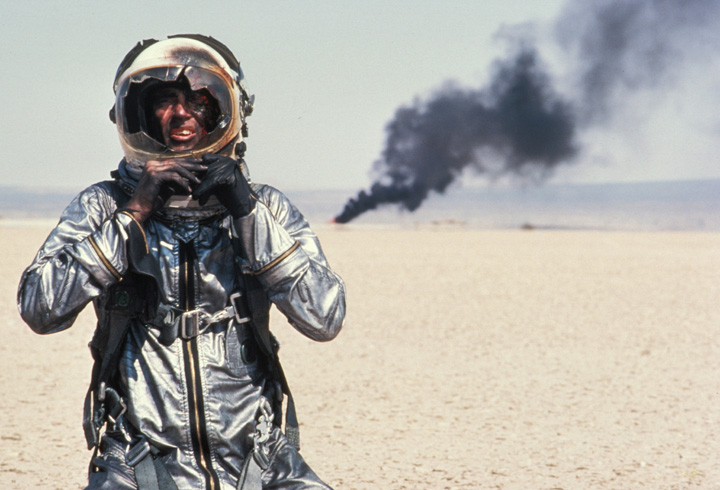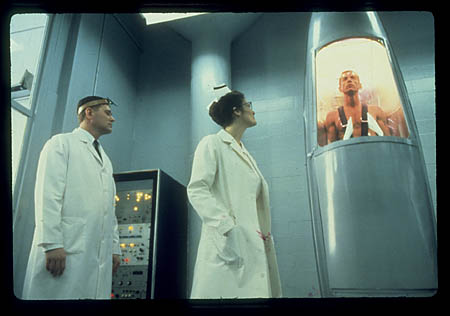
(c)1983 The Ladd Company. All.rights reserved.
“The Right Stuff” High tech = not real! The result of the efforts of the special effects staff who achieved overwhelming reality.
2020.03.28
Changes in special effects techniques
During the three months that the main production team was away from San Francisco, Gutierrez had little contact with Kaufman. The only footage that seemed usable was the scene of the Friendship 7 flying through space, which was composited against a blue screen using Classiflex and an optical printer. Even with this, the question of how to express the re-entry scene remained unresolved, and tests were repeated using various materials. As a result, the amount of film used was enormous, which increasingly strained the budget.
The USFX staff, which had swelled to 40 people, was becoming stressed. Unable to wait any longer, Gutierrez flew to Edwards Air Force Base with production manager Whitney Greene to meet with Kaufman and the producers in person. After a somewhat confrontational meeting, Kaufman ordered the suspension of work on USFX.

"The Right Stuff" (c) 1983 The Ladd Company. All.rights reserved.
At the end of June 1982, Kaufman returned to San Francisco and visited the USFX studios with cinematographer Caleb Deschanel, production designer Jeffrey Kirkland, and Jordan Belson. They actually operated the Classiflex, confirmed its functionality, and reviewed the test footage shot with the XS-1 and X-1A. He was not satisfied with the footage at all and decided to abandon motion control filming completely. He repeatedly emphasized, "Make it crazier!" In other words, he was dissatisfied with the overly choreographed footage(*7) and wanted it to be as unstable as possible, like the height of chaos.
As a result, Gutierrez was forced to reorganize his team, with Stetson returning to EEG for Brainstorm (1983). Mike Lawler, who was the cameraman for motion control photography (special effects cameraman for Star Trek: The Motion Picture and The Empire Strikes Back ), moved to BFC (formerly EEG), which was working on 2010 (1984). The loss of these veterans was a big hole, but on the other hand, it created a free and unbiased corporate culture.
*7 Even today, CG animators tend to create footage exactly as it is in the storyboard. In the actual footage, the aircraft is not neatly centered in the frame. Kaufman intended to edit the footage by blending it with real archive footage provided by NASA, the Air Force, Bell Aircraft, and others. For this reason, he wanted the desperation of those footage - the sense of a cameraman trying to keep the subject in focus - to be present in his special effects film.
In-camera studio special effects
Gutierrez decided to go in a bold direction: a revival of the low-tech, in-camera special effects of the sort that adorned so many war movies from the heyday of Hollywood studios.
First, they built lightweight, sturdy models of the XS-1 and X-1A out of hard urethane foam, so that they wouldn't break easily. Then, they laid a 24m-long camera rail inside the studio, and recreated the flight scenes using a large background panel with chalk-painted clouds on a blue sky by art supervisor Jena Hollmann (a matte artist by trade), clouds made from liquid nitrogen, and a 10kw light to represent the sun. Then, to express the reflection of a sea of clouds on the surface of the aircraft, the entire studio was covered in parachute cloth.
In addition, the atmospheric fluctuation was expressed by burning alcohol fuel in front of the camera lens, and a strong fog filter was applied to create an aerial perspective effect. Furthermore, a gauze screen was placed between the camera and the model, and the screen was fanned with electric fans and liquid nitrogen to shoot against the light, creating the feeling of a supersonic state.

"The Right Stuff" (c) 1983 The Ladd Company. All.rights reserved.
Kaufman began filming in August in a hangar at the abandoned Hamilton Air Force Base north of San Francisco using the screen process, which was used for aircraft and spacecraft cockpits, and instead of the front projection that was mainstream at the time, he used the 1930s to 1960s style rear projection. USFX and Belson also provided background footage for this process, and this collaboration also served as an opportunity for everyone to work together better.
The screen process was handled by Rick Fischer, formerly of ILM. After completing the work, he joined USFX as a special effects cameraman. By this time, the USFX staff had fully understood Kaufman's intentions and had begun to try increasingly radical techniques. First, they shot test shots on black-and-white film, developed them in 15 minutes, and showed them to Kaufman. If he gave the OK, they would immediately start production.
For example, to create the feeling of shooting from a chase plane , he began to use a telephoto lens(*8) and handheld shooting. However, shooting manually was not possible to express the violent vibrations that occur when breaking through supersonic speeds. So Gutierrez brought a Panasonic electric massager from his home, attached it to the lens, and shook the image slightly.

"The Right Stuff" (c) 1983 The Ladd Company. All.rights reserved.
However, feeling that his arm muscles were reaching their limits, Fischer brought in a motorized Eyemo(*9) from home, attached a Nikon 50-300mm zoom lens, and zoomed in while rotating the background and the model, swinging the camera around while taking pictures to express the out-of-control X-1A.
*8 In general, wide-angle lenses are used in miniature photography to increase the depth of field and emphasize the sense of perspective. However, in "The Right Stuff," telephoto lenses are used for many shots to create a documentary-like atmosphere and to create the effect of camera shake.
*9 The Eyemo is a spring-driven 35mm movie camera manufactured by Bell & Howell. Because it is small, lightweight and sturdy, it was used not only as a war camera and for shooting newsreels, but also as a "crash cam" in stunt scenes.

